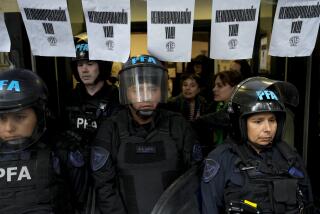IMF, in Its Largest Bailout, Will Lend Brazil $30 Billion
- Share via
BUENOS AIRES — The International Monetary Fund agreed Wednesday to its largest bailout ever, a $30-billion loan to Brazil that comes amid growing social unrest and political upheaval in South America.
The announcement came at the end of a three-nation tour of the continent by U.S. Treasury Secretary Paul H. O’Neill. The visit coincided with a major shift in U.S. policy, with the Bush administration showing increased willingness to rescue the region’s troubled economies.
O’Neill’s trip, which ended here Wednesday, also saw $1.5 billion in bailout funding for Uruguay and a U.S. promise to help speed assistance to Argentina.
“Brazil is on a solid long-term policy trend which strongly deserves the support of the international community,” IMF Managing Director Horst Koehler said in a statement.
The IMF loan may have tossed a lifeline to the moribund candidacy of ruling-party candidate Jose Serra, the choice of the international investment community. The decision comes just two months before a hotly contested presidential election in which polls show Serra running a distant third to two left-leaning challengers.
A statement from Brazil’s Economy Ministry said the government “is convinced that the [IMF] accord will serve the national interest and hopes the accord will be supported by the leading presidential candidates.”
Serra praised the agreement, saying “it increases our future economic security.” But the front-runners in the election--both strong critics of U.S. foreign policy--remained silent.
The United States is the IMF’s largest donor and would have had an important say in the negotiations over the loan.
The IMF agreement also came amid growing concerns about political instability spreading through a region racked by deepening recession. In recent weeks, violent protests have hit Uruguay, Peru and Paraguay. In Bolivia, the radical left made dramatic gains in June elections.
Nowhere has the economic crisis frayed the social fabric as much as in Argentina, where nearly a quarter of the work force is unemployed, according to official figures.
O’Neill’s visit to Buenos Aires on Wednesday was perhaps the most tense of his trip, with thousands of protesters gathering there for anti-U.S. demonstrations.
For one day, all Argentina hung on the lisping speech of the white-haired American in a charcoal suit, the highest-ranking Bush administration official to visit their country since it suffered a calamitous financial collapse late last year.
After a downtown news conference here, the climax of a 24-hour visit, it became clear that Argentines would have to settle for much less than their Brazilian and Uruguayan counterparts.
O’Neill offered mostly platitudes, words of encouragement and the promise of “technical” help with the IMF--but no firm sense of when Argentina’s wait for aid might end.
“I know that with the right polices in place the people of Argentina will succeed,” O’Neill said.
Like most Latin Americans, Argentines feel a deep ambivalence toward the United States. They believe, correctly or not, that the fate of their country is in the hands of American officials and bankers who are not doing enough to help them. But many also believe that foreign aid has become an albatross that keeps Argentina at the mercy of outsiders.
“They lend us $100 and then charge us $500 to pay it back,” said Mario Baeza, an unemployed man who joined a demonstration Tuesday night.
Most of the secretary’s itinerary in Buenos Aires was kept a closely guarded secret, lest he be accosted by the thousands of Argentines who promised to greet him with ribald chants and burning Stars and Stripes.
O’Neill came, in part, to show Argentines he felt their pain, despite a history of comments many here consider insensitive. Before leaving for South America, he suggested aid to Argentina and other countries might find its way to the Swiss bank accounts of corrupt officials instead of the needy.
On Wednesday, by contrast, he was deferential and polite, offering praise to Eduardo Duhalde, Argentina’s lame-duck president, who is leaving office early in the wake of popular discontent against his economic policies.
“My hopes for Argentina are high,” the Treasury secretary said after meeting with Duhalde and his economy minister, Roberto Lavagna.
For months, U.S. and IMF officials have badgered their Argentine counterparts to put their fiscal house in order as a condition for further support. Argentina stopped making payments on part of its $104-billion foreign debt earlier this year.
In Brazil, the new loan is also meant to encourage belt-tightening policies, even after a new government is elected in October.
U.S. analysts said the IMF loan is designed to try to lock in current government fiscal policies by making the additional money contingent on Brazil maintaining its current budget surplus, excluding debt payments of 3.75% of gross domestic product.
They said that whether the IMF is successful in halting the fall of the Brazilian currency, the real, and stabilizing financial markets depends on the reaction of opposition candidates Luiz Inacio Lula da Silva and Ciro Gomes.
“It really depends on whether they react in a reasonable way,” said Edwin M. Truman, a former assistant Treasury secretary for international affairs. “If they do, the [IMF] program has a reasonable chance of success. If they don’t, the whole thing is out the window.”
But the opposition in Brazil--as elsewhere on the continent--is under pressure to meet the needs of millions of unemployed workers.
During his visit to Argentina, the U.S. Treasury secretary took pains to show that he, too, cares about those hit hardest by the region’s crisis.
O’Neill paid a visit Wednesday morning to a “community kitchen” that feeds children in Merlo, a poor suburb of Buenos Aires.
Alerted by television reports that an important American had arrived, hundreds of people gathered outside and whistled loudly when O’Neill emerged through the front door--he smiled and waved, perhaps unaware that whistling is equivalent to booing here.
Earlier, a much smaller group of leftist demonstrators threw eggs at his motorcade as it left the downtown Economy Ministry building.
The secretary’s car sped past a line of people outside a bank--a ubiquitous sight here. Across the street, in the Plaza de Mayo, police were raising barriers to guard government buildings against an expected anti-O’Neill protest.
“If he had come here with good intentions, he could go to the Plaza de Mayo without any problems,” said Carlos Echaeue, a 66-year-old retiree, who stood near the end of the bank line. “But the best he’s going to do is give more money to the politicians for them put in their pockets.”
Like nearly everyone else in line at the bank, Echaeue was waiting to buy dollars. He would be exchanging pesos for bills with O’Neill’s signature.
Because of security concerns tied to the protests, O’Neill canceled two announced stops. One was at a Ford auto plant, where workers were preparing to plaster anti-American posters across the factory. He was also a no-show at the Eva Peron hospital in Merlo, where another large crowd had gathered.
Even before O’Neill’s visit, Argentine officials had done their best to downplay hopes it would lead to quick American aid.
“We are not expecting him to be like Santa Claus, with a bag full of presents,” said Alfredo Atanasof, the president’s Cabinet chief.
Times staff writer Peter Gosselin in Washington contributed to this report.
More to Read
Sign up for Essential California
The most important California stories and recommendations in your inbox every morning.
You may occasionally receive promotional content from the Los Angeles Times.














